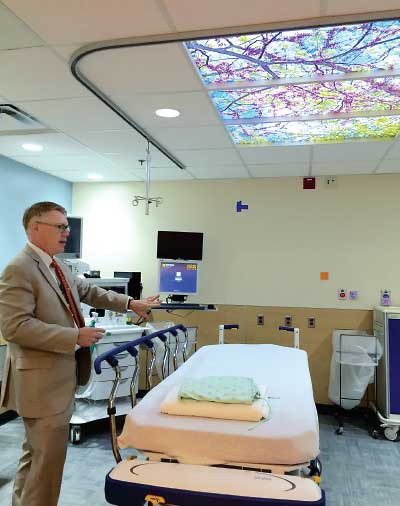Cost-Effectiveness Analysis Builds Strong Case for Third-Line Use of ECT
Abstract
Despite evidence that ECT is highly effective in treating major depression, clinicians rarely recommend it and patients are reluctant to try it.
Clinicians may want to consider electroconvulsive therapy (ECT) for patients who have failed to respond to two trials of pharmacotherapy and/or psychotherapy, according to the authors of a study published online in JAMA Psychiatry on May 9.

Daniel Maixner, M.D., stands in the treatment area of the ECT unit at the University of Michigan. Patients travel long distances to receive ECT, which is not available in many parts of the country.
“As clinicians, we always worry about patients getting routed through treatment after treatment, at which point they become more treatment resistant,” senior author Daniel Maixner, M.D., who directs the ECT program at Michigan Medicine, told Psychiatric News. “Decades of research show that ECT is the best way to produce remission. Our study highlights that if you use ECT earlier, it also becomes cost-effective.”
Relying on data from published depression studies, including STAR*D (Sequenced Treatment Alternatives to Relieve Depression), Maixner, Eric Ross, M.D., and Kara Zivin, Ph.D., of the University of Michigan Department of Psychiatry used a mathematical model to simulate cost and quality-of-life outcomes for patients with treatment-resistant depression (TRD) who are exposed to different treatments.
In the context of the study, patients were considered to have TRD if they failed two treatment lines, said Ross in an interview. A treatment line could be an antidepressant medication, psychotherapy, or both or a distinct combination of medications. Also, to qualify as failed, a treatment had to have had an adequate duration trial (eight weeks for this study).
The model projected that over four years, ECT would reduce time with uncontrolled depression from 50 percent of life-years to between 32 percent and 37 percent of life-years, with greater improvements the earlier ECT is administered. The model also predicted that utilizing ECT as a third-line treatment for depression would cost an estimated $54,000 per quality-adjusted life-year gained, well below the commonly accepted cost-effectiveness threshold of $100,000 per quality-of-life year, according to Maixner.
The annual cost of ECT can exceed $10,000 (the same is true for psychotherapy) compared with several hundred dollars for many antidepressant medications, the authors noted.
Nonetheless, Ross added, “When we say ECT is cost-effective, we are not saying that it’s going to save money, but we are saying that the money that is spent on ECT will get a very good return in terms of its improvement in health.”
Charles Kellner, M.D., chief of electroconvulsive therapy at New York Community Hospital in Brooklyn, N.Y., spoke enthusiastically of the findings. “I think this is a landmark study,” he told Psychiatric News. “The importance of the article is that it finally provides data for a rationale to use ECT earlier rather than at the very end of other treatment options. It is what the field has needed to put ECT in the correct context.”
The use of ECT has been “exceptionally uncommon and limited to patients with extensive multimorbidity,” according to a report by Samuel Wilkinson, M.D., of Yale School of Medicine and colleagues in the February Psychiatric Services. This reflects a combination of factors, including stigma, risk of cognitive side effects, and restricted access because of limited availability, the authors wrote.
“The problem is that ECT has been burdened with an unfair profile, and there is a lot of prejudice, misunderstanding, and misinformation about it,” Kellner said. “The hope was that psychotropic medications would be effective treatments for almost all cases of severe depression, but that turned out not to be true.”
Choosing a depression treatment is a personal choice that patients must make with their physician based on their preferences and experience, Ross said. “We are not saying that every patient who has failed to respond to treatment has to receive ECT, [but] our study suggests that ECT should be on the table as a realistic option as early as the third round of care.”
The study by Maixner et al. was supported by the Department of Veterans Affairs Health Services Research and Development Services grant. ■



